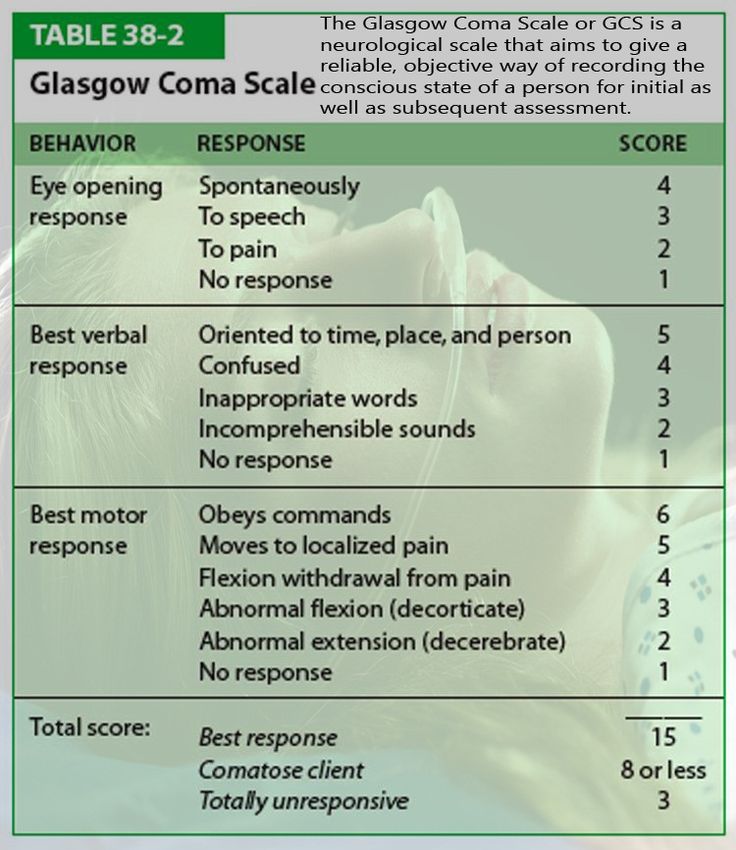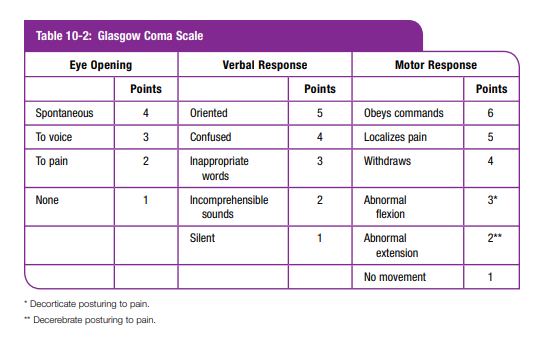

Best motor response (M) - 6 gradesApply varied painful stimulus: trapezius squeeze, earlobe pinch, supraorbital pressure, sternal rub, nail-bed pressure, etc: In writing the score, along with total score individual components are also mentioned. Any combined score of less than eight represents a significant risk of mortality. No motor response Interpretation of Pediatric Glasgow Coma ScaleĪ Coma Score of 13 or higher correlates with a mild brain injury, 9 to 12 is a moderate injury and 8 or less a severe brain injury. Extension to pain (decerebrate response)ġ. Abnormal flexion to pain for an infant (decorticate response)Ģ. Infant moves spontaneously or purposefullyģ. In children greater than 5 years of age, the responses are similar to adult Glasgow Coma Scale. Infant moans to pain, grunts, agitated and restless

Infant coos or babbles or smiles appropriately (normal activity)Ģ. Here the responses are different age wiseĥ. The main difference from adult Glasgow coma scale comes in the verbal response. The Pediatric Glasgow Coma Scale comprises of three tests: eye, verbal and motor responses as in Glasgow coma scale(GCS). Pediatric Glasgow Coma Scale – Click to ENLARGE The scale has been modified from the original Glasgow coma scale as s many of the assessments for an adult patient would not be appropriate for infants and young children. Pediatric Glasgow Coma Scale is used in cases of head injury of children mostly. The Pediatric Glasgow Coma Scale or Pediatric Glasgow Coma Score (PGCS) is the equivalent of the Glasgow Coma Scale and is used to assess the consciousness of infants and children. To avoid this Pediatric Glasgow Coma Scale, a separate yet closely related scale, has been developed for assessing younger children. The Glasgow Coma Scale has limited applicability to children, especially below the age of 36 months because then the verbal performance of even a healthy child could be labeled to be poor). This would mean, for example, eyes closed because of swelling = 1, intubated = 1, leaving a motor score of 3 for ‘abnormal flexion’.

‘E1c’ where ‘c’ = closed, or ‘V1t’ where t = tube.Ī composite might be ‘GCS 5tc’. In these circumstances, the score is given as 1 with a modifier attached e.g. In a severely injured patient with intubation and severe facial/eye swelling or damage, it is not possible to test the verbal and eye responses. Severe, with GCS less than or equal to 8.Hence, the score is expressed in the form “GCS 9 = E2 V4 M3 at 17:35”. Individual elements, as well as the sum of the score, are important in the Glasgow Coma Scale. (The patient does simple things as asked.) hand crosses mid-line and gets above clavicle when supra-orbital pressure applied.) (Purposeful movements towards painful stimuli e.g. Flexion/Withdrawal to pain (flexion of elbow, supination of the forearm, flexion of the wrist when supra-orbital pressure applied pulls part of the body away when nailbed pinched).Abnormal flexion to pain (adduction of arm, internal rotation of the shoulder, pronation of forearm, flexion of wrist, decorticate response).Extension to pain (adduction of arm, internal rotation of the shoulder, pronation of forearm, an extension of the wrist, decerebrate response).There are 6 grades starting with the most severe: (Patient responds coherently and appropriately to questions such as the patient’s name and age, where they are and why, the year, month, etc.) (The patient responds to questions coherently but there is some disorientation and confusion.) (Random or exclamatory articulated speech, but no conversational exchange) There are 5 grades starting with the most severe: In such cases a score of 4 is given, not 3.) (This should not be confused with an awakening of a sleeping person. (Patient responds to pressure on the patient’s fingernail bed if this does not elicit a response, supraorbital and sternal pressure or rub may be used.) There are 4 grades starting with the most severe: The lowest possible GCS (the sum) is 3 (implies deep coma or death), whilst the highest is 15 (implies fully awake person). The three values separately, as well as their sum, are considered.

The scale comprises three tests: eye, verbal and motor responses. Glasgow coma scale is routinely used in head injuries and other central nervous system conditions Glasgow coma scale is used to record consciousness levels of the person. Glasgow Coma Scale is a neurological scale developed by Teasdale and Jennett and is also known as Glasgow Coma Score.


 0 kommentar(er)
0 kommentar(er)
